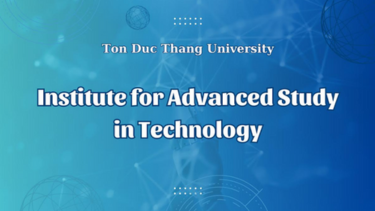Institute for Advanced Study in Technology (IAST)

The Institute for Advanced Study in Technology (IAST) of Ton Duc Thang University is a leading research and educational institution founded on April 15, 2023. It was established through the merger of two existing research institutes of Ton Duc Thang University, namely the Advanced Institute of Materials Science (AIMaS) and the Institute for Computational Science (INCOS). With a strong focus on interdisciplinary research, technology transfer, and training of highly qualified researchers, IAST strives to push the boundaries of scientific knowledge and contribute to the betterment of society.
MISSIONS:
IAST is committed to fulfilling several core missions:
- Implement a contemporary management framework aimed at attracting highly skilled scientists while nurturing a culture of creativity, accountability, and ownership. IAST fosters an environment of open communication and collaboration, empowering researchers to spearhead groundbreaking scientific advancements. By employing modern managerial practices, IAST creates an atmosphere that inspires scientists to excel and take responsibility for their work. It encourages a culture of innovation and critical thinking, enabling researchers to explore unconventional ideas and push the boundaries of knowledge.
- Perform interdisciplinary research: IAST engages in cutting-edge interdisciplinary research, employing a combination of theoretical, computational, artificial intelligence, and experimental approaches. By bringing together experts from diverse fields, IAST aims to tackle significant scientific challenges that have societal benefits.
- Develop technologies and products: Building upon the foundation laid by basic research, IAST focuses on translating scientific discoveries into practical applications. Through the development of technologies and products, IAST aims to address real-life problems and contribute to advancements in various industries.
- Transfer knowledge, skills, and technologies: IAST recognizes the importance of sharing knowledge and expertise with external organizations in both the public and private sectors. By facilitating the transfer of knowledge, skills, and technologies, IAST aims to foster collaboration and bridge the gap between academia and industry.
- Educate and train world-class scientists: IAST places great emphasis on education and training, striving to nurture highly qualified researchers. By providing a stimulating learning environment, IAST aims to produce scientists with the skills and knowledge to make significant contributions in their respective fields.
- Foster collaboration: Collaboration is a key aspect of IAST's mission. The institute actively seeks partnerships with both domestic and international research and education institutions. By fostering collaboration, IAST aims to promote knowledge exchange, share resources, and undertake joint projects to address complex scientific challenges.
RESEARCH UNITS:
IAST is home to several research units, including:
- Laboratory of Biophysics: Focuses on uncovering the molecular mechanisms of living systems and developing pharmaceuticals to treat human diseases.
- Laboratory of Advanced Materials Chemistry: Conducts research on the synthesis, characterization, and properties of advanced materials with diverse applications.
- Atomic Molecular and Optical Physics Research Group: Studies the structure of atoms, molecules, clusters, and interactions with external fields, especially focusing on the fundamental issues of the generation of ultrashort light pulses and building the groundwork for applications in areas such as quantum information processing and laser technology.
- Laboratory of Advanced Materials and Structures: Concentrates on developing advanced materials and innovative structural designs for enhanced performance and sustainability.
- Division of Computational Mechanics: involves the development of mathematical models that accurately represent the physical phenomena, coupled with the application of advanced computing techniques to analyze these phenomena. Its main areas of expertise include solid mechanics, fluid dynamics, multiscale materials, civil engineering, mechatronics, biomechanics, as well as acoustics and vibrations.
- Laboratory of Computational Physics: Engages in computational studies of physical phenomena and systems, spanning from condensed matter physics to astrophysics and particle physics, targeting advanced applications such as new and artificial material; optical communication and sensor; energy collection, storage and conversion; micro-/nano-technology microfluidic and machines; etc.
These research units cover a wide range of scientific disciplines and contribute to IAST’s interdisciplinary approach. Their research interests and expertise complement IAST’s overall mission of advancing scientific knowledge, technology development, and training of researchers.
Overall, IAST serves as a hub for interdisciplinary research, technology transfer, and training of highly qualified scientists, with the goal of making significant contributions to scientific advancement and societal well-being.